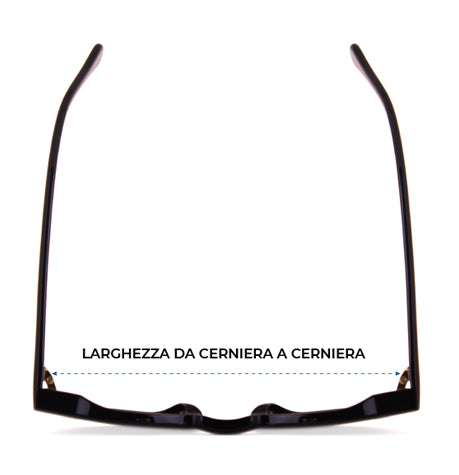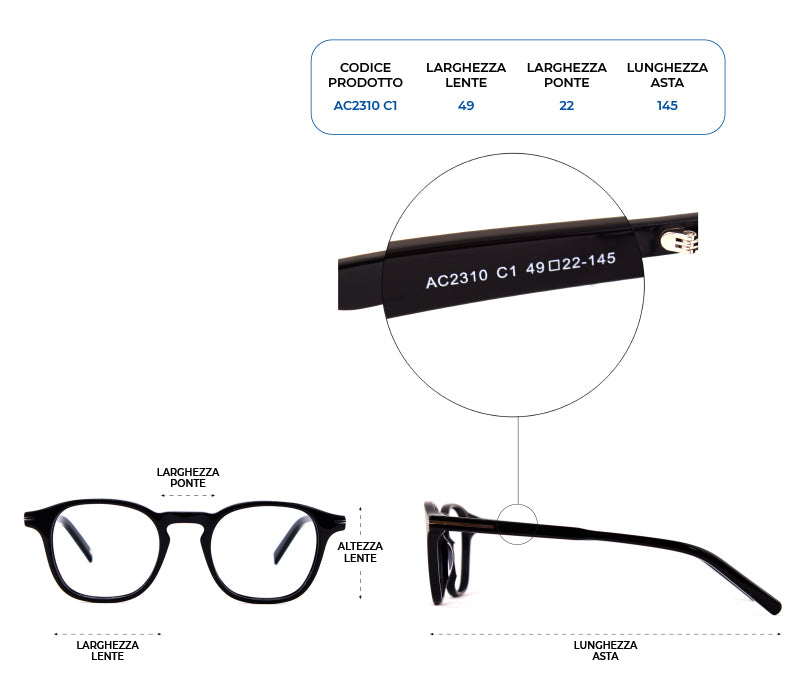Size guide
Understanding which size of glasses does for you may seem complicated, especially online. But don't worry! Whether you are looking for your first pair or want to discover the size of your current frame, we are here to help you. With a few simple steps, we will guide you to find the perfect fit for comfort, style and a crystalline vision.

Glasses measures
frame size
The size of the frame is determined by its horizontal width, calculated from the central part of the left zipper up to the corresponding central part of the right zipper, and is expressed in millimeters (mm) (image). The frames can be available in one size or in different sizes.

Other measures
Generally each frame contains the product code within the arm (model code e
color) and 3 numbers that correspond respectively to the lens width,
bridge width and arm length. (Image numbers and examples).

If you already have a pair of glasses
To identify the correct size, use a ruler and measures the distance between the hinges of a pair of glasses you already have and that are fine. Consider a tolerance of +/- 4mm.
To find the correspondence of your size, You can refer to these sizes of the sizes of suppliers.
Important: Not all companies provide the size of the width of the frame, i.e. the distance between the hinges. If this information is not present in the product sheet, we recommend that you adopt the method 2 ("If you don't have a
pair of glasses ") to determine the size
more suitable for you. Remember that, in each product sheet, you will always find the size indicated
glasses: lens width, bridge width and rod length.

If you don't have a pair of glasses
If you don't have a pair of glasses at hand and you don't know what your size is, you can find it using a credit card or a similar size card.
Place the long side of the paper in the center of the nose, align the short side to the eye and look in the mirror.
How to understand if your glasses are of the right size
To make sure your glasses are of the right size and guarantee maximum comfort and optimal vision, you can follow these simple steps.
The Bridge of the Glasses (the part that rests on the nose) should not make signs on the skin. The glasses should not slide on the nose or exert excessive pressure.
Lens width (caliber): The lenses should completely cover your eyes from any angle, without the eyes being too close to the internal or external edges of the lenses. This guarantees optimal vision and protection.
Rod length: The rods should extend straight to your ears and rest comfortably on them, without pressing too tight on the head. L'Ends of the auctions should lean gently behind the ear without causing discomfort.
Horizontal alignment: The glasses should be horizontally aligned with your eyes and not inclined on one side. This indicates that the frame adapts well to your face.
Space between lenses and eyelashes: There should be sufficient space between your eyelashes and lenses to prevent the eyelashes from touching or making lenses when beating the eyelids.
Comfort on the temples and on the nose: You shouldn't hear pressure or discomfort on the temples or on the nose bridge. A good frame adapts well without leaving signs or causing headaches.
Visibility: Make sure the vision is clear in all directions. The frames should not obstruct your view nor cause distortions. If you meet problems with one or more of these aspects, it may be necessary to adjust the frame or choose a different size. Remember, comfort and visual clarity are essential to find perfect glasses for you.







